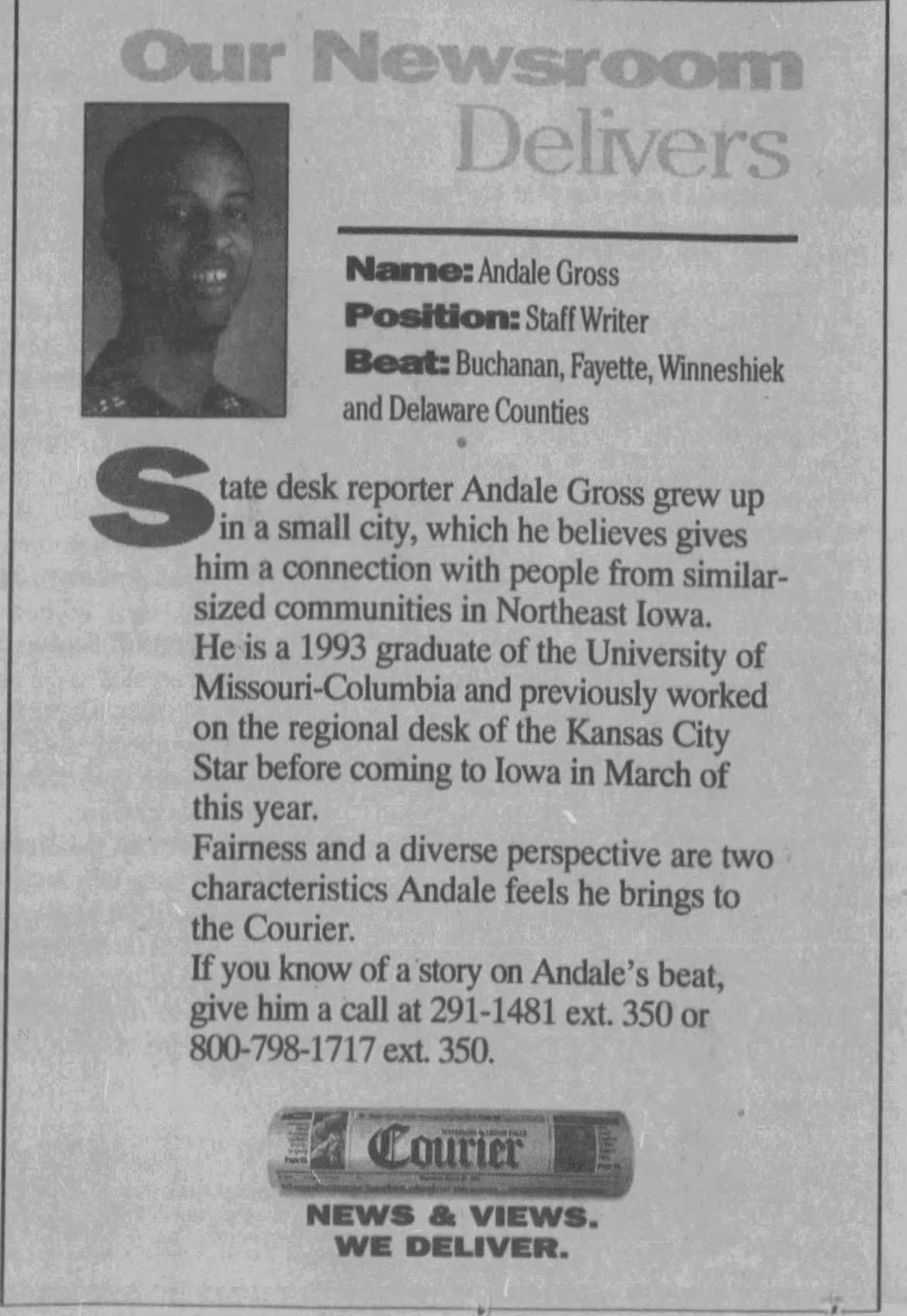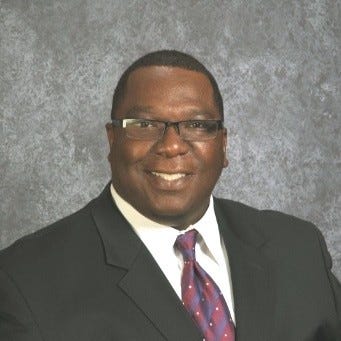Former Waterloo journalist hits it big in K.C.
Waterloo-Cedar Falls Courier alum Andale Gross is managing editor of the Kansas City Star; headed national AP team on race issues.
WATERLOO — Andale Gross was a rising star in the Waterloo-Cedar Falls Courier newsroom in the late 1990s.
He reached for the stars and is now sitting atop one — the Kansas City Star.
Gross, who most recently headed an Associated Press national reporting team on race and ethnicity, is now managing editor of the Star — the No. 2 editorial position at the paper. He oversees general operations of the newsroom, a position he’s now held almost a year.
He is the first Black managing editor in the 144-year history of the paper, which has a rich history. It has won eight Pulitzer Prizes. It’s where an 18-year-old reporter from Oak Park. Ill. named Ernest Hemingway once worked enroute to a Nobel Prize winning literary career. Decades before he became the 33rd president of the United States, an 18-year-old Harry S. Truman also briefly worked in the Star’s mailroom, wrapping newspaper bundles at $7 an hour.
Gross got to his spot at the Star from the ground up. He has worked his way through the ranks covering news from the mundane to the monumental — from compiling a rundown of Northeast Iowa county fairs to the civil unrest in Ferguson, Mo. after a grand jury decided not to indict a white police officer in the shooting death of unarmed black teenager Michael Brown in 2014. He barely avoided being tear gassed.
He was a regional reporter for The Associated Press at that time, and went on to coach reporters on how to approach similar stories and others related to race.
He led several award-winning projects as the head of the AP’s race and ethnicity team, a position to which he was appointed in 2019.
He is very active with the National Association of Black Journalists and served as a mentor for an NABJ multimedia project from 2012 to 2017.
Gross is a native of Moberly, Mo., a city with a population of 13,000 on U.S. Highway 63 about 30 miles north of Columbia, where the University of Missouri is located. He graduated in 1993 from “Mizzou,” where he was a magazine editor.
”I had hopes and dreams of being a reporter for Ebony/Jet, but in internships ended up in newspaper,” he said.
He first worked for his hometown paper, the Moberly Monitor-Index, where he not only was a reporter, “you had to copy and paste (the story) on the page with the pica pole, Exact-O-Knife” measuring and cutting it to fit prior to going to press. He shot his own photos - most of the time. “We had a really good photographer; I really felt like I was somebody when he went along with me for photos,” he said.
Gross was hired as a features writer for the newspaper’s “Fiftysomething” magazine, writing profiles on well-known people in the community over age 50. “Which is kind of funny because now I am fiftysomething,” he said. Stories ranging from the folks who ran a drive-in movie theater to an Italian family who ran a successful sausage business.
“Also, I think at the time I was the first Black reporter at the Monitor-Index, so I took it upon myself to write as much as I could about people I dealt with in the Black community,” he said. “Because I don’t think otherwise they would have had stories written about them.
”My mother has a very big family — she’s the youngest of 14 — so I think I got all my aunties into the paper somehow,” he said, laughing. “I got all the mothers and fathers of the Baptist church I grew up in into the paper.”
Moberly is in a section of north-central Missouri along the Missouri River historically known as “Little Dixie,” where, prior to the Civil War, white migrants from Southern states like Virginia and Kentucky brought slavery with them. Segregation was perpetuated through the decades after the war. Gross, as a young journalist, sought to tell that history in his hometown.
“At the time they would have a school reunion every couple of years to honor Lincoln School, which was an all-Black school before integration” with the 1954 Supreme Court decision in Brown v. Board of Education. “My grandmother and a bunch of folks, they’d have a big parade and festivities; folks would come back from all over.
“I did these really intricate (story-photo) packages about Lincoln School and the significance of it. I used it as a way to tell some of the stories I wanted to tell,” Gross said, with support from his superiors. “I had a really great editor. She was great. Old school, pretty tough, but you learned community journalism.”
The next step was a big jump — to the Minneapolis Star-Tribune. “I was on the features desk there too,” he said, writing stories about culture, food and history. “It was a fun experience. It was the first time I remember getting a paycheck of pretty significant proportion, and I said, ‘They’re going to pay me to do this?’ “
He had family in the Twin Cities and stayed with an uncle in south Minneapolis. “I had connections with my family, but it wasn’t like Moberly where I knew everybody. So cultivating stories was a little harder in Minneapolis. But it helped me develop the chops to source and find stories in a pretty short period of time with parts of the community I needed to write about.” He developed sources through family, but also working with community groups and people on staff at the paper.
“I had the same approach” as in Moberly, Gross said. “I tried to tell stories that other people wouldn’t have told….I found out later that was kind of my way of leaving my mark.”
He then worked two years in a temporary position at the Star, covering suburaban education and, eventually, the courts. in Olathe and Johnson County, Kansas. Education was a new beat, but once he learned the ropes he resumed his normal approach, looking for the stories that might not otherwise be told.
“Telling stories about the community,” he said, “learning the differences in the neighborhoods where the schools were, and tapping into who the kids were, who the families were and try to tell more community-oriented stories, with an eye on diversity.
”At the time, I didn’t know it was diversity-equity-inclusion,” he said. “I was looking to tell stories that were interesting to me, and also tell stories about people that probably wouldn’t have otherwise been in the paper had I not given them a platform. It added up to writing more about people who looked like me. At the time I was just being myself and writing about stories that appealed to me. Little did I know I was starting to tell stories nobody else thought to tell — people who are marginalized, people of color, lower income people” in the older parts of town.
A shooting between groups from rival schools, which resulted in the deaths of two people, catapaulted Gross into what he was known for — covering violent crime and its impact on a community, including any racial aspects. He teamed with two crime and courts reporters.
“I learned a lot from them. That was the story that got me ‘known,’ ” he said. “It wasn’t really on my radar,” he said. But he followed his talents — telling stories. Any kind of stories, wherever they led him. He did that from an early age.
“I came up writing through journaling, My fifth grade teacher noted I was a really good writer,” he said. “As a kid you gravitate toward what people tell you you’re good at. I kept working at it,” on school papers and the yearbook staff in high school, at Moberly Community College and at Missouri.
“I discovered the way to use writing and show my talent was through the media,” Gross said. “I was never pushed toward hard news.” The Olathe shooting was his first real blush with hard news.
He then worked at the Waterloo-Cedar Falls Courier in 1996-97. He’d met Courier Editor Saul Shapiro at a conference in Chicago while he was still a student. When the two-year temporary position at the Star was up, he found Shapiro’s business card from the conference, reached out, and was called in for an interview.
”Long story short, “I’m like, ‘That’s where I should go,’ ” Gross said of Waterloo. “Something about Saul. He was interested in me, and my best interests, and we connected. It was a great choice.” He was on the Courier’s regional desk, covering local government, police and courts in Northeast Iowa counties.
Another bit of serendipity was that the reporter who succeeded him at the Star had come from the University of Northern Iowa in Cedar Falls and was friends with former Courier intern and future staff writer and colleague Brian Graves, another Black journalist who was from Waterloo and helped introduce him to the Waterloo community. Graves is now director of marketing and communications at Sonia Shankman Orthogenic School (“The O-School”) in Chicago.
Gross was at the Courier a year and five months. “It was a very impactful year. The Courier made an impact on me. I made an impact on the Courier. And that part of my career was the bridge from where I’d been to where I was headed, in a way I couldn’t even explain then, or even know it was going to happen that way, until I got on with the rest of my career. Everything else kind of lined up.”
After the Courier came a nine-year stint at the Akron Beacon-Journal in Ohio. He started as a general assignment reporter and was promoted to the top police beat in the main newsroom, including stories on breaking crime, unsolved cases, DNA advancements, crime trends and incidents of excessive force by police.
He joined The Associated Press in 2006, first back in Kansas City for three years as s health, police and courts reporter, occasionally filling in on the desk. Then he worked 10 years at the AP bureau in Chicago, in a big job where he supervised a 14-state regional desk of reporters and visual journalists.
In addition to the Michael Brown death, he also covered the deaths of Laquan McDonald in Chicago, Sandra Bland in Texas, Philando Castile in the Twin Cities, Terence Crutcher in Oklahoma, and other Black people who were killed by law enforcement officers or who died while in custody.
That led to his AP job leading a national team on award-winning coverage of issues related to race and ethnicity, including the death of George Floyd in Minneapolis. The team gathered data from the Centers for Disease Control that showed the disproportionate impact the coronavirus pandemic was having on communities of color.
Journalists from his team also covered Ahmaud Arbery’s killing in Georgia, a Buffalo N.Y. supermarket mass shooting, and the killing of Tyre Nichols in Memphis.
It’s a far cry from his days covering white, rural Iowa towns for the Courier, where people served coffee in the middle of a City Council meeting. But, he said, “I saw the town I grew up in in those people,” and approached and covered them no different than in Moberly.
He recalled one incident, which, in retrospect, was a personally defining moment.
He recalled one night coming out of a public meeting in an community outside of Waterloo, when a carload of white kids playing rap music were “hooting and hollering” at him, trying to get his attention. He gave a nod of approval and laughed about it all the way back to Waterloo.
“I love those kinds of experiences,” he said.
He told the story to colleagues in the newsroom, and it got back to editor Shapiro, who had heard a different version of the story and thought Gross was being accosted by the youths.
He told Shapiro that was not the case — that the kids wanted to see if Gross thought they were “down or not” by playing rap music and sought his approval
He also asked the concerned Shapiro to “absolutely” not be taken off the beat he was covering.
”It was an ‘aha’ moment for me,” he said. “That was my way of saying, ‘Yes I am Black. But I don’t want to be pigeonholed covering certain types of stories. I want to be known as a reporter who can cover anything. Put me in any role with any group of people, I’m going to come back with a story. I’m going to figure out a way to work with people and tell the story.”
The man from Moberly works from his heart, and home is where his heart is. He’s firmly grounded wife Lisa, adult sons Aja and Avery and extended family. And he sees and appreciates those roots in everyone as they deal with personal and community joys and pains.
A Courier column he wrote in September 1996 after attending a National Association of Black Journalists conference in Nashville, Tenn. outlines the standards Gross has adhered to for decades.
”My aim is to stay in touch with the entire community and use balanced judgment to cover issues pertinent to the lives of residents,” he wrote.
Pat Kinney is a freelance writer and former longtime news staffer with the Waterloo-Cedar Falls Courier and, prior to that, several years at the Ames Tribune. He is currently an oral historian with the Grout Museum District in Waterloo. His “View from the Cedar Valley” column is part of “Iowa Writers Collaborative,” a collection of news and opinion writers from around the state who previously and currently work with a host of Iowa newspapers, news organizations and other publications. Click on their links below to sample their work.
The Iowa Writers’ Collaborative








